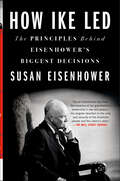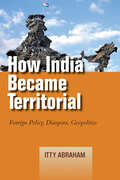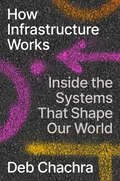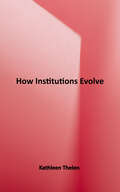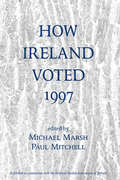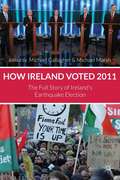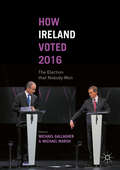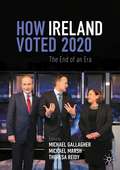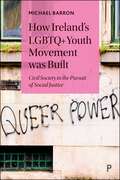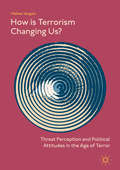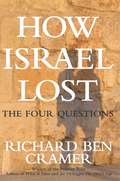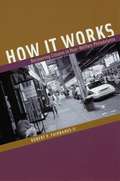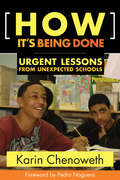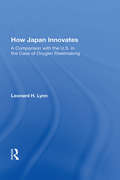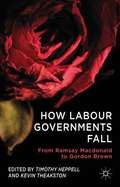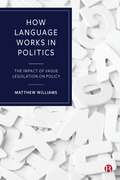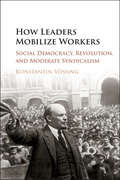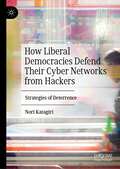- Table View
- List View
How Ike Led: The Principles Behind Eisenhower's Biggest Decisions
by Susan Eisenhower“Lays bare the essence of [President Eisenhower’s] leadership in war and peace—his singular devotion to the unity and security of the American people.” —The Wall Street JournalFew leaders have made decisions as momentous—and varied—as Dwight D. Eisenhower. From D-Day to Little Rock, from the Korean War to Cold War crises, from the Red Scare to the Missile Gap controversies, Ike was able to give our country eight years of peace and prosperity by relying on a core set of principles. These were informed by his heritage and upbringing, as well as his strong character and personal discipline—but he also avoided making himself the center of things. He was a man of judgment, and a steadying force. He sought national unity by pursuing a course he called the “Middle Way” that tried to make winners on both sides of any issue.Ike was a strategic, not an operational leader, who relied on a rigorous pursuit of the facts for decision-making. His talent for envisioning a whole, especially in the context of the long game, and his ability to see causes and various consequences, explains his success as Allied Commander and as President. After making a decision, he made himself accountable for it, recognizing that personal responsibility is the bedrock of sound principles.Written by his granddaughter, a policy analyst and national security expert, How Ike Led reveals the personality, beliefs, and habits that allowed Eisenhower to lead America through a transformational time.“As good a picture of Ike as we have ever had.” —David Nichols, author of Eisenhower 1956“Highly personal anecdotes supplement [the author’s] research. Armchair historians will treasure this book.” —BooklistIncludes photographs
How India Became Territorial: Foreign Policy, Diaspora, Geopolitics
by Itty AbrahamWhy do countries go to war over disputed lands? Why do they fight even when the territories in question are economically and strategically worthless? Drawing on critical approaches to international relations, political geography, international law, and social history, and based on a close examination of the Indian experience during the 20th century, Itty Abraham addresses these important questions and offers a new conceptualization of foreign policy as a state territorializing practice. Identifying the contested process of decolonization as the root of contemporary Asian inter-state territorial conflicts, he explores the political implications of establishing a fixed territorial homeland as a necessary starting point for both international recognition and national identity#151;concluding that disputed lands are important because of their intimate identification with the legitimacy of the postcolonial nation-state, rather than because of their potential for economic gains or their place in historic grievances. By treating Indian diaspora policy and geopolitical practice as exemplars of foreign policy behavior, Abraham demonstrates how their intersection offers an entirely new way of understanding India's vexed relations with Pakistan and China. This approach offers a new and productive way of thinking about foreign policy and inter-state conflicts over territory in Asia#151;one that is non-U. S. and non-European focused#151;that has a number of implications for regional security and for foreign policy practices in the contemporary postcolonial world.
How Infrastructure Works: Inside the Systems That Shape Our World
by Deb ChachraNAMED A BEST BOOK OF 2023 BY PUBLISHERS WEEKLY"Revelatory, superbly written, and pulsing with wisdom and humanity, How Infrastructure Works is a masterpiece.&” —Ed Yong, author of An Immense WorldA new way of seeing the essential systems hidden inside our walls, under our streets, and all around us Infrastructure is a marvel, meeting our basic needs and enabling lives of astounding ease and productivity that would have been unimaginable just a century ago. It is the physical manifestation of our social contract—of our ability to work collectively for the public good—and it consists of the most complex and vast technological systems ever created by humans. A soaring bridge is an obvious infrastructural feat, but so are the mostly hidden reservoirs, transformers, sewers, cables, and pipes that deliver water, energy, and information to wherever we need it. When these systems work well, they hide in plain sight. Engineer and materials scientist Deb Chachra takes readers on a fascinating tour of these essential utilities, revealing how they work, what it takes to keep them running, just how much we rely on them—but also whom they work well for, and who pays the costs. Across the U.S. and elsewhere, these systems are suffering from systemic neglect and the effects of climate change, becoming unavoidably visible when they break down. Communities that are already marginalized often bear the brunt of these failures. But Chachra maps out a path for transforming and rebuilding our shared infrastructure to be not just functional but also equitable, resilient, and sustainable. The cost of not being able to rely on these systems is unthinkably high. We need to learn how to see them—and fix them, together—before it&’s too late.
How Institutions Evolve: The Political Economy of Skills in Germany, Britain, the United States and Japan (Cambridge Studies In Comparative Politics)
by Kathleen ThelenThe author explains the historical origins of important cross-national differences in four countries (Germany, Britain, the United States, and Japan), and also provides a theory of institutional change over time. The latter is considered a frontier issue in institutionalist analysis, of which there are several varieties emerging from economics, political science, and sociology. Thelen's study contributes to the literature on the political economy of developed democracies that focuses on different institutional arrangements defining distinctive models of capitalism.
How Insurance Companies Settle Cases
by David FrangiamoreHow Insurance Companies Settle Cases Speed up the processing of your claims and reduce your frustration with insurance companies with How Insurance Companies Settle Cases. Knowing how insurance companies operate can help you obtain fair settlements faster. By learning what counts with the home office and what doesn't, you can present your case in its best light with minimum wasted effort, and make both you and your case stand out. This book gives you insider information that reveals how insurance companies evaluate and negotiate claims. Find answers to these questions: * How do insurance companies value cases? * What do adjusters need to settle a case? * Who makes the real decisions on insurance cases? * How do insurance companies value pre-existing injuries? * How do I prove my client really suffers from a soft tissue injury? * What is the structure of most claims departments? * How do I learn policy limits and get a copy of the insurance policy?
How Insurgencies End
by Martin C. Libicki Ben ConnableRAND studied 89 modern insurgency cases to test conventional understanding about how insurgencies end. Findings relevant to policymakers and analysts include that modern insurgencies last about ten years; withdrawal of state support cripples insurgencies; civil defense forces are useful for both sides; pseudodemocracies fare poorly against insurgents; and governments win more often in the long run.
How Insurgency Begins: Rebel Group Formation in Uganda and Beyond (Cambridge Studies in Comparative Politics)
by Janet I. LewisHow and why do rebel groups initially form? Prevailing scholarship has attributed the emergence of armed rebellion to the explosion of pre-mobilized political or ethnic hostilities. However, this book finds both uncertainty and secrecy shrouding the start of insurgency in weak states. Examining why only some incipient armed rebellions succeed in becoming viable challengers to governments, How Insurgency Begins shows that rumors circulating in places where rebel groups form can influence civilians' perceptions of both rebels and the state. By revealing the connections between villagers' trusted network structures and local ethnic demography, Janet I. Lewis shows how ethnic networks facilitate the spread of pro-rebel rumors. This in-depth analysis of conflicts in Uganda and neighbouring states speaks to scholars and policymakers seeking to understand the motives and actions of those initiating armed rebellion, those witnessing the process in their community, and those trying to stop it.
How Ireland Voted 1997 (Studies in Irish Politics)
by Michael Marsh<p>Since the elections of 1987, the Political Studies Association of Ireland has published books on each Irish general election. This latest volume covers the 1997 elections and is the first study to provide an in-depth analysis of both the campaign and the election results. <p>Written in an accessible and nontechnical style, the contributors are internationally acknowledged experts in party politics and elections. The book follows the tradition set in previous volumes in two respects: many of the contributors have written on the same topics in earlier volumes and, where appropriate, this book continues similar themes. However, How Ireland Voted 1997 places greater attention on the election campaign itself and the characteristics of the new Dail.</p>
How Ireland Voted 2011
by Michael Gallagher Michael MarshThe collapse of the Irish 'Celtic Tiger' economy, in the wake of a banking disaster, provoked a joint EU/IMF rescue plan in late 2010. The election that followed saw Europe's most successful ever party lose more than half of its vote and almost three quarters of its seats. This book provides the definitive analysis of an electoral earthquake.
How Ireland Voted 2016
by Michael Gallagher Michael MarshThis book is the definitive analysis of the 2016 Irish general election and is the eighth book in the well-established How Ireland Voted series. The 2011 election in Ireland was characterised as an earthquake, but the aftershocks visible in the 2016 election were equally dramatic. This election saw the rout of the government that had presided over a remarkable economic recovery, and marked a new low for the strength of the traditional party system, as smaller parties and independents attracted almost half of all votes. The first chapter sets the context, and later ones investigate the extent to which the outgoing government fulfilled its 2011 pledges, and how candidates were selected. The success or otherwise of campaign strategies is assessed, the results and the behaviour of voters are analysed, and the aftermath, when it took a record length of time to form a government, is explored. Other chapters examine the consequence of new gender quotas for candidate selection, consider the reasons for the unusual success of independents, and reflect on the implications. The book also reveals intriguing insights into the candidates' experiences of the election, both successful and unsuccessful. It will be of use to students, teachers and scholars of Irish politics, as well as the wider reader interested in Irish politics and elections.
How Ireland Voted 2020: The End of an Era
by Michael Gallagher Michael Marsh Theresa ReidyThis book is the 9th volume in the established How Ireland Voted series and provides the definitive story of Ireland’s mould-breaking 2020 election. For the first time ever, Sinn Féin won the most votes, the previously dominant parties shrank to a fraction of their former strengths, and the government to emerge was a coalition between previously irreconcilable enemies. For these reasons, the election marks the end of an era in Irish politics. This book analyses the course of the campaign, the parties’ gains and losses, and the impact of issues, especially the role of Brexit. Voting behaviour is explored in depth, with examination of the role of issues and discussion of the role of social cleavages such as class, age and education. The process by which the government was put together over a period of nearly five months is traced through in-depth interviews with participants. And six candidates who contested Election 2020 give first-hand reports of their campaigns.
How Ireland’s LGBTQ+ Youth Movement was Built: Civil Society in the Pursuit of Social Justice
by Michael BarronThis book offers a unique insider perspective from a queer author and activist who was centrally involved in Ireland’s journey from 1993, the year when homosexuality was decriminalised, to 2015, when it became the first country in which marriage equality was enacted by popular vote. It is the first comprehensive study of the impact of LGBTQ+ youth civil society as a leading force on Irish public policy change. Interdisciplinary in nature, it uses both activist and academic frames to reassess LGBTQ+ activism histories. It draws on personal, historical and policy analysis to provide a comprehensive account of how civil society can drive progressive change in difficult conditions. Essential reading for understanding the significant public policy changes that have occurred in Ireland, this book provides deep insight into the dynamics of organised social change over long periods of time and offers lessons for future work in this area.
How Is Terrorism Changing Us?: Threat Perception And Political Attitudes In The Age Of Terror
by Matteo VerganiThis book examines how the perception of terrorism threat erodes civil liberties, sows doubt about the loyalties of immigrants, and heightens the left-right ideological divide. The book presents original analysis of survey data and experiments conducted in Australia, Europe and the United States.Research in the book posits questions that others have largely avoided: How does the threat of terrorist violence undermine multicultural democracies? What are the psychological and social mechanisms that explain how the threat of terrorism can change political attitudes? What is the relationship between terrorism and death threats? What is the role of media in shaping the perception of terrorism threat? And what are the ethical responsibilities of journalists? This book will help readers distinguish between groundless speculation and solid scientific knowledge of the topic. Moreover, it provides concrete recommendations on how to prevent the most negative consequences of the polarization of political attitudes, such as social divisions, exclusivism and conflict. Given the broad geographical scope of the research presented in the book, specifically North America, Europe and Australia, this book will appeal to broad scope of readers.
How Islam Rules in Iran: Theology and Theocracy in the Islamic Republic
by Mehran KamravaThis study provides a comprehensive examination of the evolution of Islam as a ruling framework in postrevolutionary Iran up to the present day. Beginning with the position and structure of Iran's clerical establishment under the Islamic Republic, Kamrava delves into the jurisprudential debates that have shaped the country's political institutions and state policies. Kamrava draws on extensive fieldwork to examine various religious narratives that inform the basis of contemporary Iranian politics, also revealing the political salience of common practices and beliefs, such as religious guardianship and guidance, Islam as a source of social protection, the relationship between Islam and democracy, the sources of divine and popular legitimacy, and the theoretical justifications for religious authoritarianism. Providing access to many Persian-language sources for the first time, Kamrava shows how religious intellectual production in Iran has impacted the ongoing transformation of Iranian Shi'ism and ultimately underwritten the fate of the Islamic Republic.
How Israel Lost: The Four Questions
by Richard Ben CramerIn this &“powerful polemic that deserves to be read&” (The New York Review of Books), the major issues that have haunted Israel and Palestine for decades are insightfully explored and analyzed.With personal observation and sharp and challenging arguments, Pulitzer Prize–winning author Richard Ben Cramer insists that Israel is losing her soul by maintaining her occupation of the lands conquered in the Six Day War. Israel has become a victim of that occupation no less than the Palestinians, who must have a nation of their own. Cramer makes clear for the first time why the occupation endures and how it corrupts and corrodes the societies of both Arab and Jew. Cramer&’s portrait of those societies is both up to the minute and timeless, enlivened at every step by his trademark humor, humane understanding of the people caught in the conflict, and his astonishing gift for language, theirs and ours. The result is a book destined to produce both heat and light—it is both shocking and a delight to read. This is journalism so sharp that it will change the story it set out to tell.
How It Works: Recovering Citizens In Post-Welfare Philadelphia
by Robert P. FairbanksOf the some sixty thousand vacant properties in Philadelphia, half of them are abandoned row houses. Taken as a whole, these derelict homes symbolize the city’s plight in the wake of industrial decline. But a closer look reveals a remarkable new phenomenon—street-level entrepreneurs repurposing hundreds of these empty houses as facilities for recovering addicts and alcoholics. How It Works is a compelling study of this recovery house movement and its place in the new urban order wrought by welfare reform. To find out what life is like in these recovery houses, Robert P. Fairbanks II goes inside one particular home in the Kensington neighborhood. Operating without a license and unregulated by any government office, the recovery house provides food, shelter, company, and a bracing self-help philosophy to addicts in an area saturated with drugs and devastated by poverty. From this starkly vivid close-up, Fairbanks widens his lens to reveal the intricate relationships the recovery houses have forged with public welfare, the formal drug treatment sector, criminal justice institutions, and the local government.
How It's Being Done: Urgent Lessons from Unexpected Schools
by Pedro Noguera Karin ChenowethHow It's Being Done offers much-needed help to educators, providing detailed accounts of the ways in which unexpected schools--those with high-poverty and high-minority student populations--have dramatically boosted student achievement.How It's Being Done builds on Karin Chenoweth's widely hailed earlier volume, "It's Being Done," providing specific information about how such schools have exceeded expectations and met with unprecedented levels of success.
How It's Being Done: Urgent Lessons from Unexpected Schools
by Karin ChenowethHow It&’s Being Done offers much-needed help to educators, providing detailed accounts of the ways in which unexpected schools—those with high-poverty and high-minority student populations—have dramatically boosted student achievement.How It&’s Being Done builds on Karin Chenoweth&’s widely hailed earlier volume, &“It&’s Being Done,&” providing specific information about how such schools have exceeded expectations and met with unprecedented levels of success.
How Japan Innovates: A Comparison With The U.s. In The Case Of Oxygen Steelmaking
by Leonard L LynnThe speed with which the Japanese have adopted new industrial technology has been a major factor in their economic success, raising the question of how they have been able to carry out technological change so quickly and so smoothly, often outstripping their U.S. competitors. How Japan Innovates examines this question in depth by comparing t
How Labor Powers the Global Economy: A Labor Theory of Capitalism (New Economic Windows)
by Moshé Machover Emmanuel D. Farjoun David ZachariahThis book presents a probabilistic approach to studying the fundamental role of labor in capitalist economies and develops a non-deterministic theoretical framework for the foundations of political economy. By applying the framework to real-world data, the authors offer new insights into the dynamics of growth, wages, and accumulation in capitalist development around the globe. The book demonstrates that a probabilistic political economy based on labor inputs enables us to describe central organizing principles in modern capitalism. Starting from a few basic assumptions, it shows that the working time of employees is the main regulating variable for determining strict numerical limits on the rate of economic growth, the range of wages, and the pace of accumulation under the present global economic system. This book will appeal to anyone interested in how the capitalist mode of production works and its inherent limitations; in particular, it will be useful to scholars and students of Marxian economics.“Emmanuel Farjoun and Moshé Machover, follow up their pathbreaking work on the application of statistical physics methods to political economy in this book with David Zachariah, in which they develop methods for making educated and structured estimates of stylized facts applicable to capitalist economies. There’s a lot for economists and anyone interested in the political economy of capitalism to learn from their reasoning on these issues, including their novel and challenging suggestion of bounds on the rates of increase of use-value productivity of labor, and on the range of variation of the wage share.”Duncan K. Foley, Leo Model Professor of Economics, New School for Social Research
How Labour Governments Fall
by Timothy Heppell Kevin TheakstonWhat similarities exist between the reasons for Labour losing office in 2010 and those behind why previous Labour governments were defeated? This edited volume provides a detailed historical appraisal which considers the importance of themes such as economic performance; political leadership and the condition of the Conservatives in opposition.
How Language Works in Politics: The Impact of Vague Legislation on Policy
by Matthew WilliamsThere were more colons used in legislation in 2015 than there were words enacted in 1900. Using analysis from machine readings of all legislation enacted between 1900 and 2015, this book discusses the social impact of increasingly elastic legislative language on the contemporary workings of the British constitution. The hot-button debates of our time — from immigration to European integration, to the creeping power of judges — have, at their core, battles over what policy instructions are authoritative. The book encourages readers to connect the dots of British statecraft, and to understand how, exactly, public demands are transferred into laws that are then implemented with greater and lesser degrees of success. Crucially, it shows that vague legislation has a tremendous impact on policy delivery, disproportionately affecting the weakest, in areas including immigration, homelessness and anti-discrimination.
How Leaders Mobilize Workers: Social Democracy, Revolution, and Moderate Syndicalism
by Konstantin VössingThis book explains why leaders choose social democracy, revolution, or moderate syndicalism to mobilize workers, and why it matters. In some countries, leaders have responded effectively to their political environment, while others have made ill-fitting choices. Vössing explains not only why leaders make certain choices, but also how their choices affect the success of interest mobilization and subsequent political development. Using quantitative data and historical sources, this book combines an analysis of the formation of class politics in all twenty industrialized countries between 1863 and 1919 with a general theory of political mobilization. It integrates economic, political, and ideational factors into a comprehensive account that highlights the critical role of individual leaders. Explains the causes and consequences of differences in class politics. Conducts a rich and multifaceted empirical analysis using statistical and historical methods. Will appeal to readers who are interested in political mobilization, decision-making, or leadership.
How Liberal Democracies Defend Their Cyber Networks from Hackers: Strategies of Deterrence
by Nori KatagiriThis book outlines the main technological, legal, and operational options that liberal democratic nations have when confronting challenges in cyberspace. It offers a range of policy ideas they can adopt to make their defense stronger and deter future cyber-attacks. The author explores how liberal societies, especially those in the Western world, have so far confronted a variety of cybersecurity challenges by hackers in nondemocratic regimes like Russia and China. and zooms in on the main challenges that democratic states face in adopting strategies of cyber deterrence, and how those challenges shape their ability to actually deter hackers.
How Long How Long African American Women in the Struggle for Civil Rights: African American Women In The Struggle For Civil Rights
by Belinda RobnettA compelling and readable narrative history, How Long? How Long? presents both a rethinking of social movement theory and a controversial thesis: that chroniclers have egregiously neglected the most important leaders of the Civil Rights movement, African-American women, in favor of higher-profile African-American men and white women. Author Belinda Robnett argues that the diversity of experiences of the African-American women organizers has been underemphasized in favor of monolithic treatments of their femaleness and blackness. Drawing heavily on interviews with actual participants in the American Civil Rights movement, this work retells the movement as seen through the eyes and spoken through the voices of African-American women participants. It is the first book to provide an analysis of race, class, gender, and culture as substructures that shaped the organization and outcome of the movement. Robnett examines the differences among women participants in the movement and offers the first cohesive analysis of the gendered relations and interactions among its black activists, thus demonstrating that femaleness and blackness cannot be viewed as sufficient signifiers for movement experience and individual identity. Finally, this book makes a significant contribution to social movement theory by providing a crucial understanding of the continuity and complexity of social movements, clarifying the need for different layers of leadership that come to satisfy different movement needs. An engaging narrative history as well as a major contribution to social movement and feminist theory, How Long? How Long? will appeal to students and scholars of social activism, women's studies, American history, and African-American studies, and to general readers interested in the perennially fascinating story of the American Civil Rights movement.
